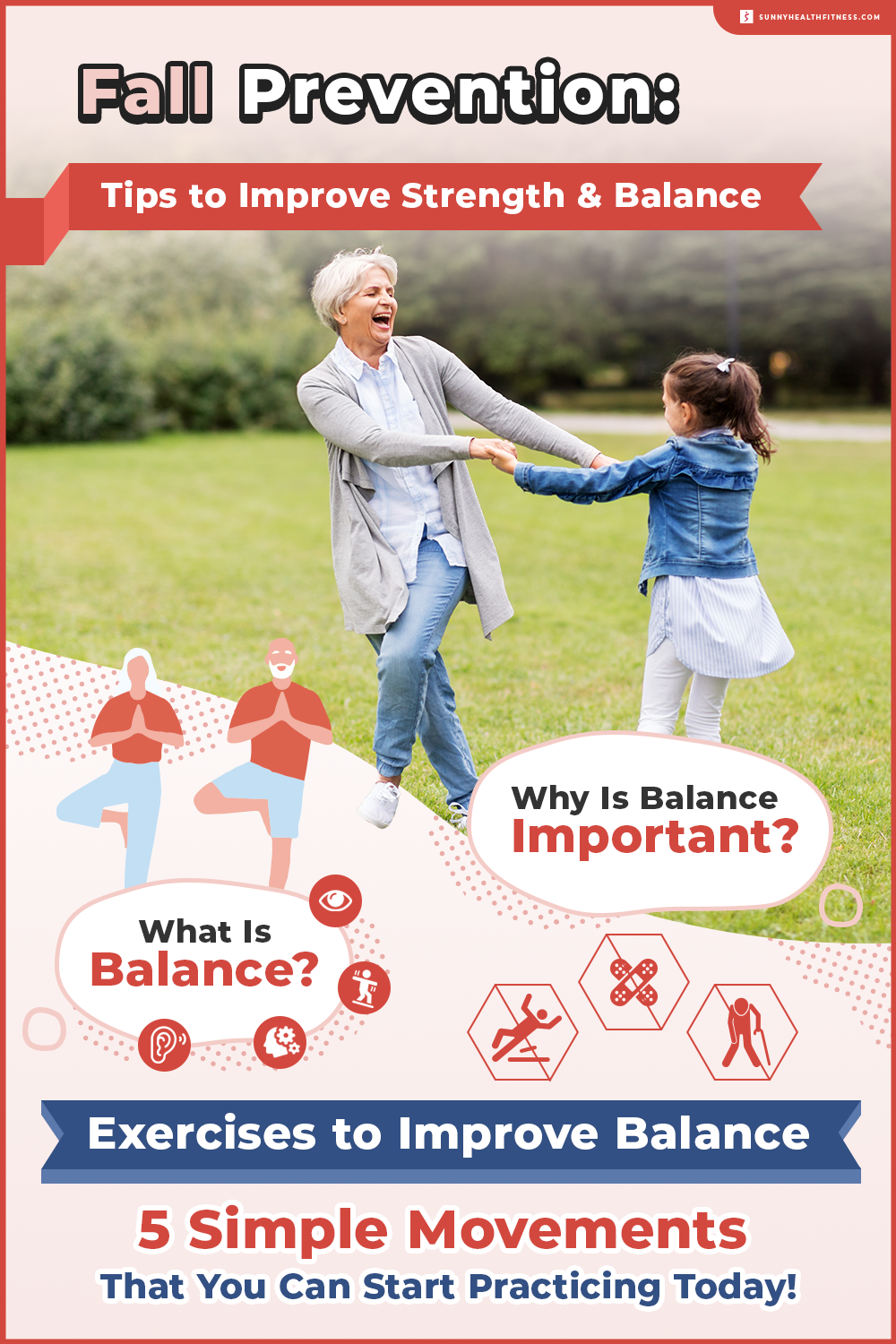Balance Basics
There is lots of talk these days about creating work/life balance or finding balance. It isn’t surprising to me that the term balance is used in these circumstances as it can be defined as a condition in which different elements are in equal proportions. Given all the buzz surrounding this topic, it is interesting that there is not a ton of focus on the importance of incorporating balance training in your exercise routine. But indeed, it should be. Improving our physical balance is just as important as creating harmony in the personal aspects of our lives.
What Is Balance?
Balance is our bodies’ ability to evenly distribute weight to remain upright. Balance involves a combination of sensorimotor systems including vision, proprioception, vestibular system (inner ear equilibrium), and motor system (muscles response to the input of different senses).
Why Is It Important?
Balance training enables your body to respond more quickly to physical demands, reduce the risk of falls, and avoid injuries(1).
Today we are going to dig a little deeper into the fall prevention benefits of balance training and what exercises you can start including in your routine.
Fall Risk
Fall risk drastically increases as we get older. According to the CDC more than one in four people over the age of 65 fall each year. After one fall, an individual’s chance of falling again doubles, and one out of every five falls results in a serious injury(2). Even if falling does not cause a serious injury, the event often discourages the person from participating in everyday activities as they become fearful of falling. It becomes a vicious cycle, as lack of physical activity eventually leads to lower body weakness and subsequent falls.
Though these statistics sound scary, there is good news. Most of the risk factors are preventable.
Common risk factors for falls include lower body weakness, poor vision, foot pain, and tripping hazards.
Keeping your house tidy to ensure that there are no lose cords or unnecessary throw rugs can help reduce your risk of tripping and falling(1).
Staying up to date with eye doctor appointments is another simple step in fall prevention, as vision is key to our ability to balance and see uneven steps(1).
However, one of the best tactics in fall prevention is to increase your strength and balance(1). Lower body weakness and difficulty balancing can be improved with simple daily movement and practice.
Even though the risk is greater as we age. Balance training is important for all ages to improve stability throughout all movement.
Let’s go over a few exercises that you can start to incorporate into your daily routine today!
Exercises to Improve Balance
Single Leg Balance

This is typically the exercise that comes to mind when discussing balance. You may not realize how much you are on one foot at a time, but it actually occurs quite frequently throughout your day. Walking, dancing, and climbing stairs all include single leg balance at one point or another. Training balance in a stationary position is the first step. This exercise will build strength in your legs and core while also shedding light on unilateral differences between the two sides of your body. For safety, be sure to have some type of support nearby when training balance.
Fun Fact: Did you know that the longest recorded single leg balance is 76 hours and 40 minutes(3)? Curious about how he slept.
Tandem Feet

Ever wonder why walking on a straight line is more difficult than your typical gait? When you walk heel to toe, you end up narrowing your base of support like you do in single leg balance; however, you also challenge lateral stability(4). Impaired lateral stability is a key factor in falls among older adults. 95% of hip fractures are caused by falling and most of these falls happen to the side(5). The goal is to be able to stand with the heel of one foot to the toe of the other with equal weight in both feet. It is common to put more weight in the back foot, but if you can evenly distribute your weight, you will activate more of your stabilizing muscles in your core rather than solely focusing on lower body strength.
Practicing the tandem foot position will not only help to improve lateral stability, but you may also find out that you have a knack for tight rope walking!
Single leg Toe Taps to Knee Lift

Now that we have practiced two static poses, it is time to incorporate some movement. Single leg toe taps add a dynamic element to balance training. Try to remain in static upright position on one leg while the other leg taps to the front, side, back and finally lifts to a 90-degree hold. Physical therapists use these types of exercise to improve lower body stability with patients recovering from a stroke or help athletes dealing with knee injuries(6). This exercise helps to better mimic your balance needs in daily life where one side is performing a task and the other stabilizes.
If you want to go the extra mile you can add a band around your ankle to build extra glute strength.
Lateral Lunge

Activities of daily life (ADLs) are multiplanar in nature, meaning you are required to move in all different directions. Lateral lunges move through the frontal plane (side to side) instead of the sagittal plane (front to back), enabling our ability to build strength in multiple directions of movement. When compared to a forward lunge, lateral lunges demonstrate a greater impact on ankle flexion and extension, increasing strength in the joint’s ability to stabilize(7). Standard squats and lunges rely heavily on larger muscle groups while a lateral lunge more easily activates the smaller, stabilizing muscles of the legs and core to increase lateral stability.
When performing a lateral lunge, it is important to do your best to keep your toes in line with each other as you step out to the side and push your hips back. Practice a smooth transition of weight from both feet in the standing position to the foot stepping to the side as you lunge and back to both as you return. You can intensify the move with a return to a single leg balance instead of a normal stance, practicing the shift of weight from one foot to the other.
Eyes Closed Calf Raises

Calf raises on their own are a great test of balance; however, adding the task of closing your eyes takes this exercise to a whole new level. Before you try this at home, you will want to first practice the calf raise and then practice simply standing with your eyes closed. Standing with your eyes closed may sound easy, but it is more difficult than you think. Closing your eyes forces you to rely on your proprioception, your body’s ability to sense your movements and position in space. When performing this exercise be sure to have a support system like a chair or wall nearby for safety.
Finding Balance
There you have it, five simple movements that you can start practicing today!
For each of these moves, 30 to 60 seconds will suffice, with two to three repetitions. Balance training is great to add to your warmup or even add at the end of your workout for an extra challenge to your core and should be done at least twice a week.
Check out the Sunny Health and Fitness YouTube Channel and the SunnyFit® App for more ways to improve your strength and balance!
1. National Institute of Aging. (2022). Falls and Fractures in Older Adults. U.S. Department of Health and Human Services, https://www.nia.nih.gov/health/falls-and-fractures-older-adults-causes-and-prevention. Accessed 6 September 2023.
2. Centers for Disease Control and Prevention. (2023) Facts about Falls. U.S. Department of Health and Human Services, https://www.cdc.gov/falls/facts.html. Accessed 6 September 2023.
3. Guinness World Records. (2023) Longest Duration Balance on One Foot. [London]: Guinness World Records, https://www.guinnessworldrecords.com/world-records/209621-longest-duration-balancing-on-one-foot. Accessed 6 September 2023.
4. Hile, E. S., Brach, J. S., Perera, S., Wert, D. M., VanSwearingen, J. M., & Studenski, S. A. (2012). Interpreting the need for initial support to perform tandem stance tests of balance. Physical therapy, 92(10), 1316–1328. https://doi.org/10.2522/ptj.20110283. Accessed 6 September 2023.
5. Parkkari, J., Kannus, P., Palvanen, M., Natri, A., Vainio, J., Aho, H., Vuori, I., & Järvinen, M. (1999). Majority of hip fractures occur as a result of a fall and impact on the greater trochanter of the femur: a prospective controlled hip fracture study with 206 consecutive patients. Calcified tissue international, 65(3), 183–187. https://doi.org/10.1007/s002239900679. Accessed 6 September 2023.
6. Ahmed, U., Karimi, H., Amir, S., & Ahmed, A. (2021). Effects of intensive multiplanar trunk training coupled with dual-task exercises on balance, mobility, and fall risk in patients with stroke: a randomized controlled trial. The Journal of international medical research, 49(11), 3000605211059413. https://doi.org/10.1177/03000605211059413. Accessed 6 September 2023.
7. Riemann, B., Congleton, A., Ward, R., & Davies, G. J. (2013). Biomechanical comparison of forward and lateral lunges at varying step lengths. The Journal of sports medicine and physical fitness, 53(2), 130–138. https://pubmed.ncbi.nlm.nih.gov/23584319/. Accessed 6 September 2023.






























Add Your Name & Email
Please enter your name and email to continue.We won’t display your email publicly.